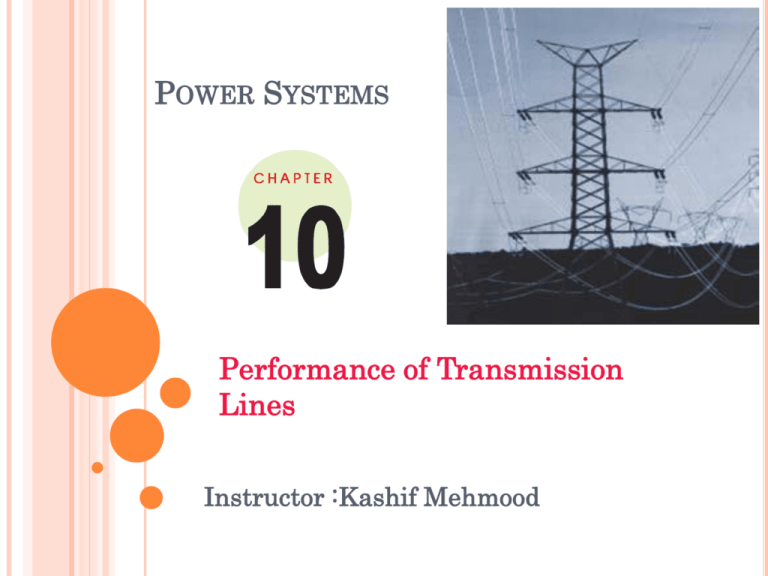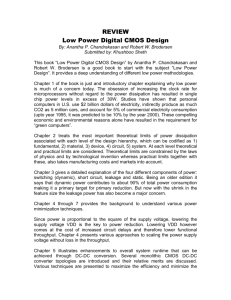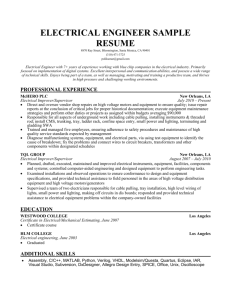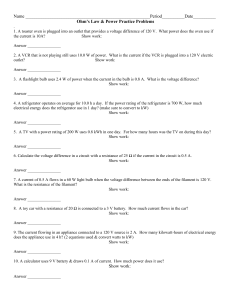Classification of Overhead Transmission Lines
advertisement

POWER SYSTEMS Performance of Transmission Lines Instructor :Kashif Mehmood The important considerations in the design and operation of a transmission line are the determination of voltage drop, line losses and efficiency of transmission. These values are greatly influenced by the line constants R, L and C of the transmission line. For instance, the voltage drop in the line depends upon the values of above three line constants. Similarly, the resistance of transmission line conductors is the most important cause of power loss in the line and determines the transmission efficiency. Classification of Overhead Transmission Lines:A transmission line has three constants R, L and C distributed uniformly along the whole length of the line. The resistance and inductance form the series impedance. The capacitance existing between conductors for 1-phase line or from a conductor to neutral for a 3-phase line forms a shunt path throughout the length of the line. Therefore, capacitance effects introduce complications in transmission line calculations. Depending upon the manner in which capacitance is taken into account, the overhead transmission lines are classified as : 1 (i) Short transmission lines. When the length of an overhead transmission line is up to about 50km and the line voltage is comparatively low (< 20 kV), it is usually considered as a short transmission line. Due to smaller length and lower voltage, the capacitance effects are small and hence can be neglected. (ii) Medium transmission lines. When the length of an overhead transmission line is about 50-150km and the line voltage is moderately high (>20 kV < 100 kV), it is considered as a medium transmission line. Due to sufficient length and voltage of the line, the capacitance effects are taken into account. (iii) Long transmission lines. When the length of an overhead transmission line is more than 150 km and line voltage is very high (> 100 kV), it is considered as a long transmission line. For the treatment of such a line, the line constants are considered uniformly distributed over the whole length of the line. It may be emphasized here that exact solution of any transmission line must consider the fact that the constants of the line are not lumped but are distributed uniformly throughout the length of the line. 3 Important Terms While studying the performance of a transmission line, it is desirable to determine its voltage regulation and transmission efficiency. We shall explain these two terms in turn. (i) Voltage regulation: When a transmission line is carrying current, there is a voltage drop in the line due to resistance and inductance of the line. The result is that receiving end voltage (VR) of the line is generally less than the sending end voltage (VS). This voltage drop (VS − VR) in the line is expressed as a percentage of receiving end voltage VR and is called voltage regulation. The difference in voltage at the receiving end of a transmission line between conditions of no load and full load is called voltage regulation and is expressed as a percentage of the receiving end voltage. Mathematically, % age Voltage regulation = Obviously, it is desirable that the voltage regulation of a transmission line should be low i.e., the increase in load current should make very little difference in the receiving end voltage. 4 (ii) Transmission efficiency: The power obtained at the receiving end of a transmission line is generally less than the sending end power due to losses in the line resistance. The ratio of receiving end power to the sending end power of a transmission line is known as the transmission efficiency of the line i.e. where VR, IR and cos φR are the receiving end voltage, current and power factor while VS, IS and cos φS are the corresponding values at the sending end. 5 Performance of Single Phase Short Transmission Lines As stated earlier, the effects of line capacitance are neglected for a short transmission line. Therefore, while studying the performance of such a line, only resistance and inductance of the line are taken into account. The equivalent circuit of a single phase short transmission line is shown in Fig. Here, the total line resistance and inductance are shown as concentrated or lumped instead of being distributed. The circuit is a simple a.c. series circuit. Let I = load current R = loop resistance i.e., resistance of both conductors XL = loop reactance VR = receiving end voltage cos φR = receiving end power factor (lagging) VS = sending end voltage cos φS = sending end power factor 6 7 Three-Phase Short Transmission Lines For reasons associated with economy, transmission of electric power is done by 3-phase system. This system may be regarded as consisting of three single phase units, each wire transmitting one-third of the total power. As a matter of convenience, we generally analyze 3-phase system by considering one phase only. Fig.(i) shows a Y-connected generator supplying a balanced Yconnected load through a transmission line. Each conductor has a resistance of RΩ and inductive reactance of XLΩ. Fig. (ii) shows one phase separately. The calculations can now be made in the same way as for a single phase line. 8 Effect of Load P.F. on Regulation and Efficiency The regulation and efficiency of a transmission line depend to a considerable extent upon the power factor of the load. 1. Effect on regulation. The expression for voltage regulation of a short transmission line is given by : The following conclusions can be drawn from the above expressions : (i) When the load p.f. is lagging or unity or such leading that IR cos(φR) > IXL sin(φR), then voltage regulation is positive i.e., receiving end voltage VR will be less than the sending end voltage VS. (ii) For a given VR and I, the voltage regulation of the line increases with the decrease in p.f. for lagging loads. (iii) When the load p.f. is leading to this extent that IXL sin(φR) > IR cos(φR), then voltage regulation is negative i.e. the receiving end voltage VR is more than the sending end voltage VS. (iv) For a given VR and I, the voltage regulation of the line decreases with the decrease in p.f. for leading loads. 9 It is clear that in each case, for a given amount of power to be transmitted (P) and receiving end voltage Power Factor Regulator Power Factor Meter 2. Effect on transmission efficiency. The power delivered to the load depends upon the power factor. (VR), the load current I is inversely proportional to the load p.f. cos φR. Consequently, with the decrease in load p.f., the load current and hence the line losses are increased. This leads to the conclusion that transmission efficiency of a line decreases with the decrease in load power factor. 10 Medium Transmission Lines In short transmission line calculations, the effects of the line capacitance are neglected because such lines have smaller lengths and transmit power at relatively low voltages (< 20 kV). However, as the length and voltage of the line increase, the capacitance gradually becomes of greater importance. Since medium transmission lines have sufficient length (50-150 km) and usually operate at voltages greater than 20 kV, the effects of capacitance cannot be neglected. Therefore, in order to obtain reasonable accuracy in medium transmission line calculations, the line capacitance must be taken into consideration. The capacitance is uniformly distributed over the entire length of the line. However, in order to make the calculations simple, the line capacitance is assumed to be lumped or concentrated in the form of capacitors shunted across the line at one or more points. Such a treatment of localizing the line capacitance gives reasonably accurate results. 11 The most commonly used methods (known as localized capacitance methods) for the solution of medium transmissions lines are: (i) End condenser method (ii) Nominal T method (iii) Nominal π method. End Condenser Method In this method, the capacitance of the line is lumped or concentrated at the receiving or load end as shown in Fig. This method of localizing the line capacitance at the load end overestimates the effects of capacitance. In Fig., one phase of the 3-phase transmission line is shown as it is more convenient to work in phase instead of line-to-line values. 12 Let IR = load current per phase R = resistance per phase XL = inductive reactance per phase C = capacitance per phase cos φR = receiving end power factor (lagging) VS = sending end voltage per phase. Limitations: Although end condenser method for the solution of medium lines is simple to work out calculations, yet it has the following drawbacks : (i) There is a considerable error (about 10%) in calculations because the distributed capacitance has been assumed to be lumped or concentrated. (ii) This method overestimates the effects of line capacitance. 13 Nominal T Method In this method, the whole line capacitance is assumed to be concentrated at the middle point of the line and half the line resistance and reactance are lumped on its either side as shown in Fig. Therefore, in this arrangement, full charging current flows over half the line. In Fig., one phase of 3- phase transmission line is shown as it is advantageous to work in phase instead of line-to-line values. IR = load current per phase ; R = resistance per phase XL = inductive reactance per phase ; C = capacitance per phase cos φR = receiving end power factor (lagging) VS = sending end voltage/phase V1 = voltage across capacitor C 14 Nominal π Method In this method, capacitance of each conductor (i.e., line to neutral) is divided into two halves; one half being lumped at the sending end and the other half at the receiving end as shown in Fig. It is obvious that capacitance at the sending end has no effect on the line drop. However, its charging current must be added to line current in order to obtain the total sending end current. IR = load current per phase R = resistance per phase XL = inductive reactance per phase C = capacitance per phase cos φR = receiving end power factor (lagging) VS = sending end voltage per phase 15 Long Transmission Lines It is well known that line constants of the transmission line are uniformly distributed over the entire length of the line. However, reasonable accuracy can be obtained in line calculations for short and medium lines by considering these constants as lumped. If such an assumption of lumped constants is applied to long transmission lines (having length excess of about 150 km), it is found that serious errors are introduced in the performance calculations. Therefore, in order to obtain fair degree of accuracy in the performance calculations of long lines, the line constants are considered as uniformly distributed throughout the length of the line. Rigorous mathematical treatment is required for the solution of such lines. 16 Analysis of Long Transmission Line (Rigorous method) Fig. shows one phase and neutral connection of a 3-phase line with impedance and shunt admittance of the line uniformly distributed. Consider a small element in the line of length dx situated at a distance x from the receiving end. Let z = series impedance of the line per unit length y = shunt admittance of the line per unit length V = voltage at the end of element towards receiving end V + dV = voltage at the end of element towards sending end I + dI = current entering the element dx I = current leaving the element dx 18 Generalized Circuit Constants of a Transmission Line In any four terminal network, the input voltage and input current can be expressed in terms of output voltage and output current. Incidentally, a transmission line is a 4-terminal network ; two input terminals where power enters the network and two output terminals where power leaves the network. Therefore, the input voltage VS and input current IS of a 3-phase transmission line can be expressed as : where VS = AVR + BIR IS = CVR +DIR VS = sending end voltage per phase IS = sending end current VR = receiving end voltage per phase IR = receiving end current and A, B, C and D (generally complex numbers) are the constants known as generalized circuit constants of the transmission line. The values of these constants depend upon the particular method adopted for solving a transmission line. Once the values of these constants are known, performance calculations of the line can be 19 easily worked out.





